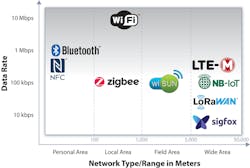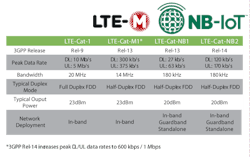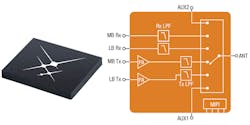Download this article in PDF format.
Thanks to the wide range of wireless connectivity technologies available today, consumers and enterprises are able to acquire data that can provide a host of marketing, operational, and design insights. Research firm IDC estimates global commerce for the Internet of Things (IoT) will surpass $1 trillion by 2022, spread across consumer, enterprise, healthcare, and industrial applications. As the promise of a wirelessly connected world becomes a reality, there’s a growing need for LTE technologies that address low cost, long battery life, security, and reduced complexity—all critical components for the IoT.
Connectivity Options for IoT Devices
Massive growth has turned the IoT into a fragmented market with a diverse set of applications and use cases. Whether indoor or outdoor, fixed or mobile, low or high data rate, there are wide ranging and often differing requirements. To address this fragmentation, IoT device manufacturers are utilizing a broad spectrum of networking protocols in both licensed and unlicensed bands.
Wi-Fi and Bluetooth have been the most popular standards for personal area networks (PANs) and local area networks (LANs), with newcomers like LoRaWAN and WiSUN gaining traction for field area networks (FANs) and wide area networks (WANs) (Fig. 1). While these protocols offer various features and benefits, each has tradeoffs in power consumption, coverage, and cost. In this article, we focus on the licensed bands for low-power wide area networks (LPWAN) networks, and in particular, LTE connections for IoT.
1. A range of wireless connectivity protocols target different networks.
Benefits of LTE for IoT
Since many IoT devices are sold and used globally, a key requirement is having a secure connection to the internet—anytime, anywhere. To ensure this safe, ubiquitous connectivity, devices may require a cellular connection—whether via 4G LTE, or even legacy 2G or 3G standards. A cellular connection guarantees a level of quality and reliability that cannot be achieved with other technologies.
Developed by 3GPP and built on GSM and UMTS technologies, LTE has become the de facto cellular communication standard. LTE network deployments are extensive, and the technology offers multiple user-equipment categories with varying data rates, performance, and cost. This flexibility enables LTE to address the full spectrum of IoT applications, from high-bandwidth, high-data-rate applications such as gaming and mobile computing, to low-power, low-data-rate applications like smart metering and asset tracking. With the onset of 5G, IoT devices utilizing LTE technology today will need to be forward-compatible with the next-generation standard.
The majority of IoT devices are expected to find homes in low-data-rate applications, which is where LTE’s value starts to emerge. Frequently referred to as Mobile-IoT (M-IoT), this includes LTE for machines (LTE-M) and narrowband-IoT (NB-IoT) (Fig. 2). These technologies are being deployed on existing LTE networks, with NB-IoT deployments occurring in-band or within the guard bands between higher-category LTE carriers. M-IoT supports data rates below 1 Mb/s and as low as 30 kb/s, offering IoT device makers the flexibility to address both voice- and data-centric applications.
2. This table compares different forms of LTE technology.
Designers have embraced M-IoT connectivity in their products for a number of reasons. It’s ideal for any application requiring secure, real-time device-to-cloud connectivity that can be used for remote monitoring, control, and management. M-IoT enables LPWAN connectivity not only for well-known consumer devices like pet trackers and smartwatches, but also for industrial applications like oil and gas metering, machine monitoring, and factory warehousing. It’s also being widely deployed, with more than 100 LTE-M/NB-IoT networks announced or launched as of May 2019, according to the GSMA.1
LTE-M and NB-IoT feature an improved power-consumption profile, partly because they work in half-duplex mode, taking turns sending and receiving data instead of simultaneously doing both. The standards also support power-saving modes as a core feature of how the network and device communicate. As such, these technologies are extremely attractive for battery-powered IoT devices.
In addition to the power savings, using half-duplex architecture reduces the complexity and cost of the front end, which is critical for “billions” of connections. To complement LTE-M and NB-IoT, LTE Cat-1 is beneficial for voice-based IoT applications like alarm panels and ATM machines, as well as for music streaming through wearable devices that require higher data rates and lower latency.
Another key benefit of LTE for end users is a more seamless connection experience—no need for passwords or pairing. An LTE-enabled IoT device is always connected to a cellular network and can be remotely provisioned as needed.
The security of LTE provides another differentiator. LTE devices utilize an embedded SIM to identify the device on a network in which the network utilizes multiple authentication and encryption schemes. In addition, quality-of-service (QoS) controls provided by the network ensure the best encrypted data handling and lowest traffic latency possible.
Design Considerations for Adding LTE Connectivity
Product designers should address some important considerations up front when incorporating LTE. First, it’s imperative to know where the device will operate—if it’s a global or a regional SKU. The required band coverage will determine the amount of gain and filtering that will be needed, as well as the network-operator performance requirements.
Other key considerations include the required data rate for the device, whether it will support voice commands, or if it will need to maintain backward compatibility with legacy 2G/3G networks. These factors determine which cellular modem platform can be used: LTE Cat-1, LTE-M, NB-IoT, or 2G/3G. The battery choice also greatly impacts how connectivity is implemented. If a direct battery connection is required without the use of a regulator (either internal to the cellular modem platform or external), the RF front end needs to operate over a wide supply voltage range. Therefore, voltage range and current consumption become key factors in power-amplifier (PA) selection.
Further, LTE device certification can be lengthy and time-consuming. Devices need to pass network operator certification (Verizon, AT&T, etc.), 3GPP standards (Global Certification Forum-GCF), as well as industry (Lightweight M2M) and regulatory certification (FCC, CE, etc.). Fortunately for product designers, there are turnkey LTE module manufacturers and modem vendors that address these certifications as part of their product offering.
Finally, since products can incorporate multiple connectivity standards, an LTE-enabled device should not violate coexistence requirements with other radios such as GPS and Wi-Fi. Ensuring coexistence of a mix of RF technologies within the typically confined physical space of an IoT device can be quite challenging.
The Design Decision
Product designers face the typical “make-or-buy” decision when looking to add LTE connectivity to any IoT device. Creating a solution in-house offers the most flexibility, but it also carries significant risk. Without a strong understanding of the standard specifications and extensive experience in RF, design engineers can make critical mistakes, resulting in wasted development time and resources.
In addition, a number of common issues often emerge when testing an LTE device: limited range, higher-than-expected current consumption, insufficient output power, degraded receiver sensitivity, and increased spurious emissions. These challenges can typically be traced back to the RF front-end component selection, printed-circuit-board (PCB) layout, antenna design, and PA matching and filtering.
Unfortunately, such problems spring up even when the design looks good in simulation, or even as an engineering prototype. For consumer IoT devices with short product lifecycles, time-to-market is a huge competitive advantage. This is one of the reasons why LTE adoption has been limited to date—manufacturing iterations to optimize LTE connectivity is time- and cost-intensive. To expedite time-to-market, it has become increasingly important for original equipment manufacturers (OEMs) to have a fully integrated, certified connectivity solution.
3. The SKY68020-11 LTE universal multiband front-end module supports cellular LTE-M/NB-IoT transceiver platforms.
With its experience in developing innovative solutions over successive technology generations, Skyworks enables seamless LTE connectivity for IoT devices. Specifically focused on designing products with IoT applications in mind, Skyworks offers cost-effective RF wireless engines that address requirements such as global band coverage, integrated functionality, direct battery connectivity, and network and regulatory compliance. For example, the SKY680xx series of LTE universal multiband front-end modules are powering millions of IoT devices on networks worldwide through collaboration and reference designs with major modem platform vendors (Fig. 3).
Skyworks is also pioneering die-level intelligent integration into M-IoT, leveraging its PA design and system engineering experience with advanced packaging techniques to develop system-in-package (SiP) solutions. The SKY66430-11 is a fully certified all-in-one M-IoT solution that integrates Sequans’ Monarch platform with the entire RF front end in a single 8.8- × 10.8- × 0.95-mm package (Fig. 4). This fully shielded device provides a complete solution for OEMs looking to streamline the design process and expedite commercialization.
4. The SKY66430-11 is a multiband, multichip SiP that operates over a frequency range of 700 to 2,200 MHz.
With consumers expecting always-on connectivity and IoT devices proliferating across the globe, M-IoT technology will become more prevalent. Manufacturers must be ready to respond with the most advanced wireless solutions that simplify design and support multiple protocols and standards.
On that front, Skyworks has developed discrete and integrated solutions that support full-duplex cellular/LTE, Wi-Fi, Bluetooth, LoRaWAN, Thread, and Zigbee. By taking advantage of a full suite of process and packaging technologies, Skyworks can offer RF front-end solutions to meet the diverse and fragmented needs of the IoT market.
Sri Sridharan is involved with Product Marketing at Skyworks Solutions Inc.
Reference:
1. GSMA, May 2019, https://www.gsma.com/iot/mobile-iot-commercial-launches/





